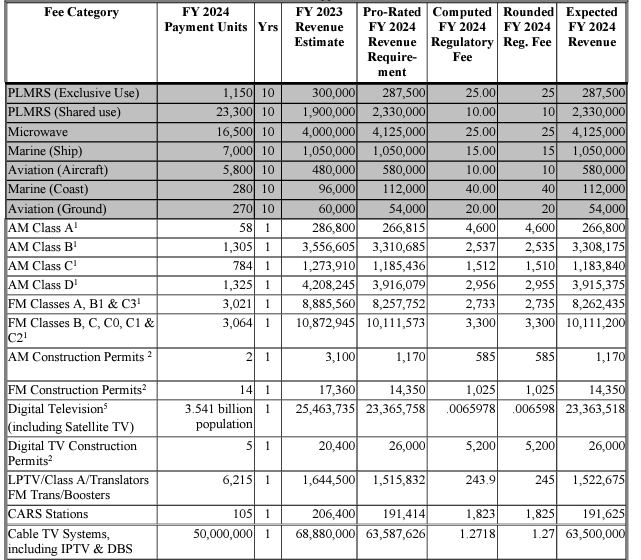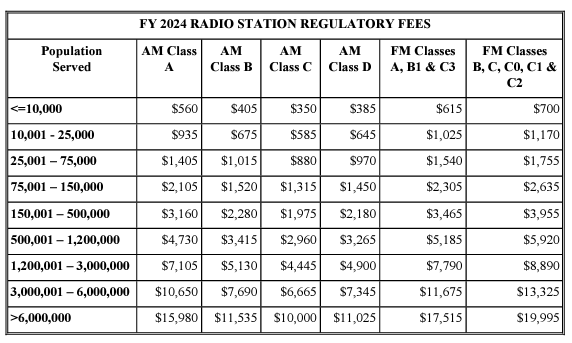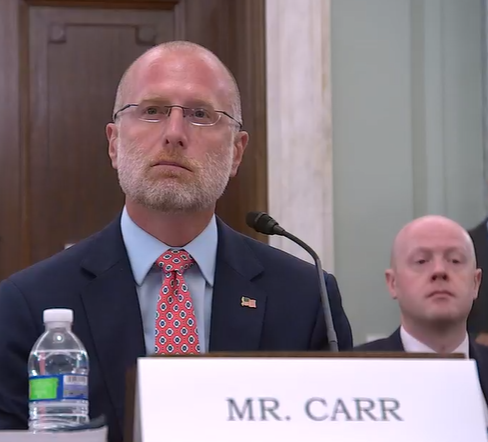Each year, the FCC has the task of an adopting a schedule of regulatory fees to be collected by the end of September. For fiscal year 2024, the Commission is required to collect a grand total of $390,192,000 in regulatory fees, payable through a collection of forfeitures for rule violations and, largely, through a fee schedule.
This fee schedule has been adopted by the Commission, albeit with reservations from the senior Republican Commissioner at the FCC.
The 149-page “Second Report and Order” detailing the regulatory fee schedule for this year was released on Friday. In it, a proposal offered in its Notice of Proposed Rulemaking for the calculation of television broadcaster regulatory fees was adopted.
This will see the FCC use its “traditional methodology of population-based full-service broadcast television regulatory fees.” There is one exception: the Commission will continue to base assessments on limiting the population count of full-power television stations that rely on satellite television stations to reach terrain-limited areas in Puerto Rico.
“We are adopting a factor of $.006598 per population served for FY 2024 full-power broadcast television station fees,” the FCC said.
With that, the FCC moved ahead with the following revenue requirements and pro-rata fees for FY 2024:
 The revenue fees are as follows:
The revenue fees are as follows:
- AM Radio Construction Permits: $585
- FM Radio Construction Permits: $1,025
- Digital TV Construction Permits: $5,200
- Low Power TV, Class A TV, TV/FM Translators & FM Boosters (47 CFR part 74): $245

Additionally, the FCC offered FY 2024 fees for each full-service broadcast television stations by call sign. For instance, KABC-7 in Los Angeles has a regulatory fee of $116,590, based on its terrain limited population versus service area population; it is one of the nation’s most-watched TV stations and presently blocked from view by all DirecTV subscribers in the vast L.A. DMA due to the lack of a retransmission consent agreement. In contrast, KAEF-23 in Eureka-Arcata, Calif., has an $819 regulatory fee, given its smaller market size.
The highest regulatory fee in the nation goes to WCBS-2 in New York, based on its signal coverage and the population its broadcast signal serves, coming in at roughly $150,000.
AN END TO ‘DARK STATION PRESUMPTION’
The FCC is also adopting a proposal to discontinue “the presumption that broadcast stations that are dark or were recently dark or bankrupt are experiencing financial hardship sufficient to justify waiver of their regulatory fees.”
This is occurring despite opposition from state broadcasters’ associations and the NAB. The State Broadcasters argue that the facts underlying the policy’s implementation have not changed, that no matter why a station goes dark, when it goes dark it experiences financial hardship that may cause it to cease operation altogether. NAB argues that the policy eliminates a financial burden to silent stations attempting to return to operating status and a barrier to potential investment in stations that were recently dark or bankrupt.
In response, the Rosenworcel Commission commented, “Neither commenter … disputes nor addresses the Commission observation that the presumption underlying the policy is no longer accurate in FY 2024 … Because the Commission considers all of a licensee’s assets and revenue streams in determining its ability to pay regulatory fees, the silence of one of its stations does not necessarily affect the licensee’s ability to pay the regulatory fees it owes, including for the silent station.”
Similarly, the FCC contends, “it is not accurate to assume that, across-the-board, newly purchased stations that were previously dark or bankrupt are insufficiently financed to cover the station’s first year of operation. The station owner may very well have sufficient funds – other revenue streams or start – up financing to pay the station’s regulatory fees in its first year of operation.”
The end of the “dark station presumption” will apply for FY 2025 regulatory fees, and not to those for fiscal year 2024.
Meanwhile, the Commission said it would to a limited extent continue pandemic-related relief, with the Office of Managing Director continuing to assess the lowest interest rate permitted by statute and forgo the customary down payment for fee payors who are eligible for installment payment relief.
Regulatory fees cover all of the FCC’s non-auctions costs — including direct costs, such as salaries and expenses; indirect costs, such as overhead functions; statutorily required tasks that do not directly equate with oversight and regulation of a particular regulatory fee payor but instead benefit the Commission and the industry as a whole; and support costs, such as rent, utilities, and equipment. That’s based on Congressional legislation requiring the FCC to develop a sensible plan of action for funding itself; the FCC collects these regulatory fees to offset the annual funding that Congress provides to the Commission through the appropriations process.
CARR: ‘DELETE UNNECESSARY PROCESSES’
Like former FCC Commissioner Ajit Pai, Brendan Carr seeks more “light-touch” regulatory approaches to governing the nation’s broadcasters and broadband service providers.
This is why is approved in part, and dissented in part, the FY 2024 regulatory fee order.
“Determining who pays and how much is the subject of regular tussling within the agency’s docket,” Carr said. “That makes sense. The FCC does not have an entirely free hand here, though. A lot of the agency’s cuts are driven by determinations that Congress has made and codified in federal law. And the Commission is not going to make everyone happy. More often, regulated entities walk away with the feeling that they are being compelled to pay for the red tape that they will confront down the road.”
Over the past several years, Carr added, he’s worked with his fellow Commissioners “to make progress on our approach to collecting and assessing regulatory fees.” Still, he concluded, “I believe the Commission can make even more progress in maximizing our efficiency as a government agency. That starts with first principles thinking. Question every requirement. Delete unnecessary processes. Then simplify and optimize. If we start there first, then our regulatory fee process will align more closely with efficient outcomes. As it stands today, we’re leaving too many cumbersome processes in place, putting lots of staff time into working through the issues and appeals and challenges that result from those processes, and then passing those staff time costs on to some businesses (but not others). That’s not the most efficient approach or one that scales very well. I want to see the agency move more quickly in reforming our processes.”




